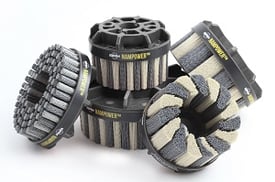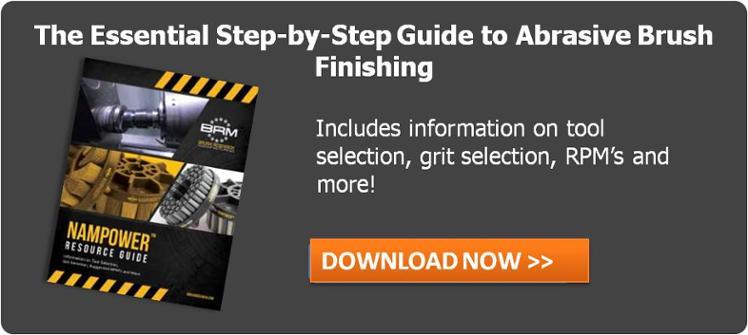 NamPower discs from Brush Research Manufacturing (BRM) are nylon abrasive brushing tools that remove burrs and improve part finish at the same time. Designed for outer diameter (OD) applications, these high-performance metalworking tools integrate easily with CNC machining centers, transfer lines, robotic cells, and other production equipment. With their unique combination of ceramic and silicon carbide abrasive, NamPower disc brushes set a new standard for high-quality, cost-effective performance.
NamPower discs from Brush Research Manufacturing (BRM) are nylon abrasive brushing tools that remove burrs and improve part finish at the same time. Designed for outer diameter (OD) applications, these high-performance metalworking tools integrate easily with CNC machining centers, transfer lines, robotic cells, and other production equipment. With their unique combination of ceramic and silicon carbide abrasive, NamPower disc brushes set a new standard for high-quality, cost-effective performance.
NamPower disc brushes come in two styles (dot and turbine), two trim lengths (18 and 38 mm), four grit sizes (80, 120, 180, 320), and six diameters (50, 60, 80, 100, 125, 150 mm). Choosing the right tool for the job is important, of course, but your work doesn’t end with product selection. That’s why manufacturers, metalworkers, and machinists need to understand the importance of disc brush speed, which is measured in revolutions (RPM) per minute, for optimum NamPower performance.
Finding the Best Brush Speed
 Did you know that the maximum RPMs that are marked on a brushing tool may not be the optimum working speed for your specific surface finishing application? The NamPower Resource Guide provides suggested speeds by disc brush diameter and grit size, but finding the right speed for your metalworking application may require machine trials.
Did you know that the maximum RPMs that are marked on a brushing tool may not be the optimum working speed for your specific surface finishing application? The NamPower Resource Guide provides suggested speeds by disc brush diameter and grit size, but finding the right speed for your metalworking application may require machine trials.
Many factors affect optimum RPMs, but there are four that are particularly important:
- Brush diameter
- Trim length
- Feed rate
- Cut depth
Guidelines and Machine Trials
As the NamPower Resource Guide explains, smaller-diameter NamPower disc brushes run at faster speeds – regardless of grit size. Excessive brushing speeds, especially with longer trim lengths, can cause filaments to flare and bounce-off the workpiece, however. To avoid flaring, note that coarser grit filaments can spin faster than finer grit filaments and that turbine-style brushes for medium and heavy-duty deburring can spin faster than dot-style disc brushes for light deburring.
Feed rate and cut depth also affect disc brush speed. As a rule, contoured surfaces are processed at slower speeds and greater depth of interference than flat surfaces. Starting feed rates between 30 inches per minute (IPM) and 80 IPM are recommended, but the final feed rate is application-specific and must be developed through deburring trials. With regard to cut depth, spindle speed is usually decreased with increased depth of interference so that the filaments can conform smoothly to part contours.
Get the NamPower Resource Guide
Do you have questions about NamPower disc brush selection or use? For complete information, download the NamPower Resource Guide. This free, full-color technical publication from Brush Research Manufacturing contains suggested parameters and explains how you can optimize your operating parameters.









